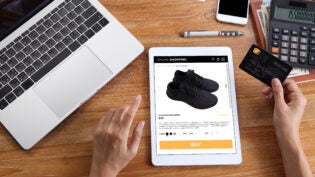Home > Technology > eCommerce >
How eCommerce, Augmented & Virtual Reality will Redefine the Retail Experience
By: Chris Horton

eCommerce; Augmented Reality (AR); Virtual Reality (VR): Three rapidly evolving digital technologies that have long held the theoretical promise of delivering more convenient, enhanced and immersive shopping experiences to consumers.
However, like many other aspects of business in the digital age, speculative theory is fast turning into tangible reality. eCommerce, AR and VR are here to stay, and, both individually and collectively, are poised to completely overturn our conventional understanding of the retail shopping experience.
eCommerce: Creating a More Convenient (Personalized) Shopping Experience
As a complement to brand websites, eCommerce sites have added functional depth to the internet economy, providing users a highly convenient way to research, compare, and purchase goods and services from anywhere, anytime.
Anecdotal evidence from the US Department of Commerce suggests the eCommerce sector is experiencing far more rapid growth than the retail sector as a whole.
U.S. retail eCommerce sales for the 2nd quarter of 2013 were approximately $64.8 billion, an estimated 18.4 percent increase from the 2nd quarter of 2012, while total retail sales increased just 4.7 percent in the same period.
A 2014 eConsultancy survey of 2013 holiday shoppers revealed that 50% of US respondents did more than half of their Christmas shopping online, while 34% did less than half; in other words, fully 84% completed at least some of their 2013 holiday shopping via eCommerce.
Moreover, given the phenomenal speed in consumer adoption of smartphones and tablets, the future of eCommerce is inevitably tied to mCommerce. In the US, mCommerce sales hit $10.6 billion in the first half of 2013 alone.
mCommerce users expect highly personalized and convenient user experiences that organically integrate with their daily lives. For businesses, this means preparing for total consumer engagement over multiple screens simultaneously as consumers shift from desktop computers to smartphones and tablets to research and purchase goods and services.
Many retailers are beginning to prepare for the consumer transition to mobile by fitting out their stores with near-field communication (NFC), a technology which supports data transfer over short distances, to encourage shoppers to purchase in-store merchandise online with a wave of their smartphones.
With access to increasingly sophisticated user profiling and data mining techniques, brands are now able to utilize algorithmic recommendations to deliver ever more personalized experiences to consumers, providing tailor-made purchase suggestions by collecting previous consumer behavioral data from various online channels. In the near future, many brands will leverage m-commerce functionalities like augmented reality (AR) apps to further enhance the shopping experience; by doing so, they will continue to blur the lines between the physical and the virtual worlds and hasten the inevitable convergence of internet and retail to create fully integrated shopping experiences.
Augmented Reality: Creating an Enhanced Shopping Experience
Given its mobile-friendly interface, the next logical step for many brands to enhance the shopping experience is to leverage augmented reality technology. According to data from Juniper Research, 60 million users across smartphones, tablets and smart glasses will utilize Augmented Reality apps in 2014; this number is expected to more than triple to 200 million unique users by 2018.
Augmented reality blurs the lines between what is real and what is computer generated; it links the real and virtual worlds, using digital technology to enhance a person’s external surroundings. Augmented reality provides additional information so the user can view the world in a different manner. In this way, augmented reality should be understood as an externally focused digital interface.
Lending to this, nearly all augmented reality tools are apps for mobile devices such as smartphones, tablets or wearables. Augmented reality provides a digitally enhanced view (reality) of the world in which we live and interact on a daily basis. Doing so requires a filter or lens (i.e. a smartphone, tablet, or wearable) to properly distill, or view, this enhanced reality.
Google’s Glass and Innovega’s iOptik lens system are prime examples of wearable AR technology in action, while Amazon’s new iOS app offers a glimpse into the possibilities of augmented-reality shopping. The Amazon app allows shoppers to snap a photo of a product instead of scanning the barcode or typing the name of the item into a search bar. It then pulls up the product from the photo, allowing customers to purchase it instantly.
At its core, augmented reality is all about enhancing the user experience; as such, brands are starting to wake up to the utility of AR to enhance the consumer shopping experience.
Virtual Reality-Creating an Immersive Shopping Experience
Creating a convenient shopping experience is good; creating an enhanced one is great; but creating fully immersive shopping experience…well, that is ideal.
In contrast to augmented reality, virtual reality technology creates a completely immersive, computer generated environment. Advanced computer, networking, display, interaction, and graphics technologies allow brands to create photorealistic 3D scenes; to view, hear, touch, and even smell the computer generated environment. Virtual reality is all about convincing the user they are in a place where they actually are not. In this way, virtual reality can be understood as an internally focused, totally immersive digital interface.
Facebook’s recent two billion dollar acquisition of immersive virtual reality brand Oculus brings the innumerable applications of virtual reality back into the fore. As Facebook CEO Mark Zuckerberg noted in a conference call regarding the acquisition, “there aren’t many things that have the potential to be the next big computing platform…Oculus has the potential to be the most social platform ever. Immersive, virtual and augmented reality will be part of people’s daily lives.”
Running through the litany of real-world applications of his new toy, Zuckerberg found time to reflect on the impact of VR technology on advertising and e-commerce: “Imagine going shopping in a virtual store just by putting on goggles in your own home,” he said. “We’ll keep building out the ad platform as part of this.”
Facebook isn’t alone in recognizing the promise of VR technology. A recent post in Venture Beat reports that Sony has recently rolled out its own VR headset, Project Morpheus, which will work with the PlayStation 4 home gaming console. Citing the advances made by comparable efforts like the Oculus Rift, Sony head of research and development Richard Marks said that he expects virtual reality to become the preferred medium for “all sorts of applications.”
I can only imagine that virtual shopping will be among them.
The Platforms of Tomorrow
As is the case with many other manifestations of digital technology which have impacted business in innumerable ways, relative newcomer eCommerce represents but the tip of a very large iceberg encroaching upon the existing retail landscape. Following in its wake are two nascent technologies- augmented reality and virtual reality- each with the holding the promise and power to redefine the shopping experience in ways we cannot, as yet, fully comprehend.
In his interview concerning the Oculus acquisition, Zuckerberg had this to say about the future of social technology: “Mobile is the platform of today, and now we’re also getting ready for the platforms of tomorrow…Oculus has the chance to create the most social platform ever, and change the way we work, play and communicate.”
And shop.
This article was originally published by SyneCore
Published: April 15, 2014
3322 Views
3322 Views












